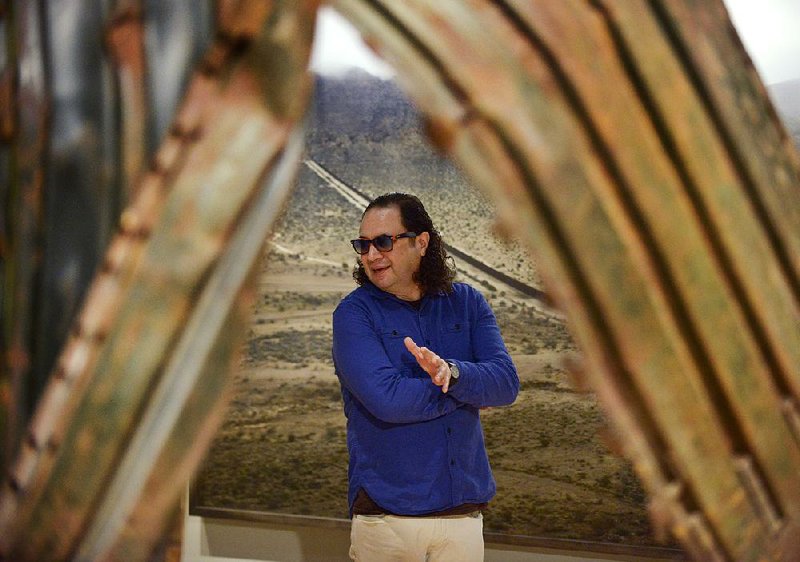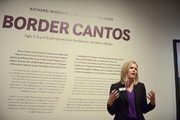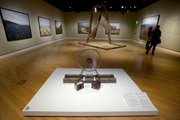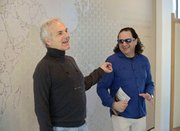Richard Misrach has been capturing images along the U.S.-Mexico border since about 2004, well before the area became what he described as a daily "prime-time news event."
RELATED ARTICLE
http://www.arkansas…">Bridging Borders
When the California-based photographer began collaborating with sculptor and composer Guillermo Galindo several years later on a project that would become "Border Cantos: Sights and Sound Explorations from the Mexican-American Border," he still couldn't imagine its current relevance.
"It's uncanny," Misrach said. "There's no way we had any idea."
Neither did Crystal Bridges Museum of American Art, whose first exhibition of 2017 focuses on the cultural and political divide between the bordering countries. "Border Cantos" -- which opens Saturday -- features large-scale landscape photographs, artifacts left behind by border crossers, sculptures, and musical instruments crafted from objects collected along the 2,000-mile border across California, Arizona, New Mexico and Texas.
"Border Cantos" arrives at Crystal Bridges in Bentonville after stints at the San Jose Museum of Art in San Jose, Calif., and the Amon Carter Museum of American Art in Fort Worth last year. Ali Demorotski, the curator for the exhibition at Crystal Bridges, hopes guests will visit with an "open mind."
"They're not trying to take a political stance," Demorotski said of the artists. "They're really presenting the place and the people that are being affected by the wall and by the militarization of the border. It's not confronting you with specific people and specific stories and really trying to make anyone feel guilty. It's really open-ended to create a space to think and to kind of react, engage where you're coming from and maybe why you feel that way."
Misrach has spent much of his career photographing the American desert, which is part of an ongoing collection of landscape photos that, like the current exhibit, bear the "Desert Cantos" title.
His travels through the Southwest have taken him to the border, where about 680 miles of steel walls and fence have been constructed to deter illegal immigration. In 2009, Misrach said he started noticing an increased militarization along the border and the area began drawing the focus of his camera more.
The collaboration with Galindo began in 2011, when Misrach attended a performance in which he played original compositions on instruments made from objects found along the Texas border. The two began working together on the "Border Cantos Sights and Sound Explorations from the Mexican-American Border" project a year later, wanting to give people "the experience of the border" through sights and sounds.
In his travels, Misrach would photograph and collect objects along the border. He would then take them to Galindo, who would craft them into sculptures and instruments. One example: The Angel Exterminador (Exterminating Angel), a mangled piece of the border wall dangling by a chain from a wooden frame.
"I started getting more ambitious over time," said Galindo, whose 260-minute original score of music from border instruments can be heard throughout the gallery. "This is one of my most ambitious things. Richard asked me what I wanted, and I said I wanted part of the wall."
Most of the photographs in the exhibition are landscapes featuring parts of the border wall or objects left behind by travelers. Misrach said he purposely avoided photographing people, instead focusing on the border wall or left-behind items like shoes, water bottles, clothes or tuna cans.
Agua #1, which Misrach photographed near Calexico, Calif., in 2004 proved to be the first photo in the project. It featured a blue barrel with the word "agua" and a wind-tattered blue flag. Similar barrels containing gallons of water are left for travelers in the remote parts of the desert by humanitarian groups.
Galindo used one such barrel in an accompanying piece called The Fountain of Tears.
"I would find things, and he would get ideas from it," Misrach said of the collaboration with Galindo. "He would do things, which would give me ideas that I would be sensitized to see in the landscape. It was this back and forth. ... That dynamic was so important for this project and the way our two mediums and practices sort of inspire each other."
"Border Cantos" also is the first full-scale bilingual exhibition at Crystal Bridges. Every part of the exhibition -- including labels, quotes and brochures -- are in English and Spanish.
To prepare, the museum formed an advisory committee consisting of Hispanic community leaders throughout Northwest Arkansas to aid in the planning process. The group met once a month dating back to August, offering feedback and guidance for a project that became timely throughout the 2016 presidential election campaign, especially in regard to the anti-immigrant rhetoric of the winner, Donald Trump.
Sonia Gutierrez, founder and chief operations officer of the New Design School in Fayetteville, was a member of the "Border Cantos" advisory committee. Gutierrez said she believes that art has an incredible power to move, educate and enlighten and is looking forward to the public's response to "Border Cantos."
"It's open. It's not telling you what to think," Gutierrez said last month. "It's only showing what is there, and it leaves it to the viewer to make that choice. That's what is beautiful about it, and you interpret it however you need to and apply it however you want."
The exhibition, which is free to the public, will be on view until April 24.
Misrach said, "I'm making something about today, but hoping that 30 years from now people will look back at this and kind of learn lessons about who we were at this historical moment."
Metro on 02/17/2017



